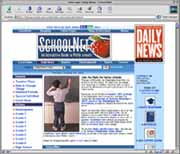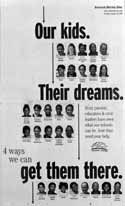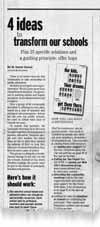Fall 2001
Three Models of Schools Coverage
A Philadelphia Daily News Web site launched in September is providing critical information and venues for parents and teachers to communicate at a time when the city faces tough decisions about its failing education system.
A town hall sponsored by two daily newspapers and eight television stations in Tucson, AZ, drew an audience of 300 and prompted 80 people “to pledge” their involvement in improving the education of Tucson’s children.
A Savannah Morning News project led to “Vision 2010, ” four benchmarks to improve the public schools in 10 years.
Three cities. Three media partnerships. Three civic journalism projects aimed at encouraging parents and other community members to take an active approach to the problems that plague their schools.
Following are highlights of their activities:
Daily News Launches SchoolNet
By Catherine Lee
Pew Center
Parents and teachers in the School District of Philadelphia have a new way to share ideas thanks to an interactive Web site launched by the Daily News at the start of the school year.

SchoolNet, which provides contact information to district offices, grade-by-grade learning requirements for students and online chat rooms for parents and educators, was up and running just a few days after schools opened in September.
“We want to help everyday Philadelphians fix their schools,” said Daily News editor Zack Stalberg. “SchoolNet helps widen the circle of good ideas during this crucial year for the school system. The Internet gives the Daily News a new tool to broadcast our stories and our call for action.”
The site has drawn praise from the school system.
“Anything that connects parents to schools and communities to newspapers is valuable as we move forward in this process of trying to reform the schools,” said Alexis Moore, the district’s executive director of communications.
SchoolNet’s home page, at http://schoolnet.philly.com, invites people to “join the fight for better schools.”
One of its goals “is to give people a place where they can communicate with each other, share ideas, share concerns,” said Deborah Licklider, new initiatives editor at the Daily News. “We really see it as a vehicle for keeping the conversation going.”
As part of the paper’s “Rethinking Philadelphia Schools” project, the site also archives the paper’s education stories, which continue to chronicle events impacting the district.
The district and the state of Pennsylvania have been engaged in talks that could turn over management of the schools to the private Edison Schools Inc., which runs 136 schools nationwide. An Edison report was due at the end of September. An agreement on a long-term solution for the school system is due by the end of November.
On the Web site, menu choices include several “channels” or e-mail forums that allow educators and others to share ideas and discuss solutions. The “How to Change Things” channel is a place where people can swap ideas about improving schools. “Teacher Place” provides a forum for dialogue involving parents, educators and other school supporters.
One link delivers users to pages with detailed information about what kids are expected to learn from year to year. Another provides a grade-by-grade vocabulary list for parents with sometimes-confusing terms like IEP, which stands for individualized educational program. The district requires an IEP for children with special needs.
Salome Thomas-El, principal of John F. Reynolds Elementary School in North Philadelphia who has written a book about his commitment to inner-city public schools, said that the Web site is “long overdue.” Thomas-El said that parents can get to the Web site using computers at Reynolds.
“Parents have access to so much information on the site,” said Thomas-El. “In the past, they’d have to wait on the phone for hours.”
Brochures about the Web site are available at all 54 Philadelphia public libraries, where the public also can log on to computers. The Daily News plans to host two one-hour workshops in October, one on school choice and another on helping kids with their homework.
The Daily News also planned to co-sponsor a Philadelphia Chamber of Commerce breakfast where Edison founder Christopher Whittle would talk about the company’s report on the district.
Savannah: A Community Reform Plan
By Catherine Lee
Pew Center
The back-to-school special section features student faces, quotes from the superintendent and school board president and pictures of teachers and principals.

But it is not your typical school start-up coverage. There are also photos of 57 members of the community.
The 18-page section in the Aug. 26 Savannah Morning News delivers on a year’s worth of work by these community members, who aggressively researched how to turn around Savannah’s schools by the end of the decade.
Working with the paper and several other partners on “Vision 2010,” community members met 14 times, visited 21 schools – including seven models around the country – and volunteered about 1,600 hours to craft a plan for the city’s ailing schools. Of the 35 “Vision 2010” stories that ran in the paper, 19 were written by community members.
They compressed all their knowledge into four key recommendations and issued report cards on how the public schools were performing in each area:
- Put decision-making power into the hands of parents, teachers and principals.
- Offer parents and students more choices.
- Accept no excuses for poor performance.
- Recruit and reward exceptional leaders for the schools and classrooms.
Prior to the section’s publication, “Vision 2010” members met with Superintendent John F. O’Sullivan Jr. and School Board President Diane Cantor to present their ideas for reform.
O’Sullivan promised to consider the group’s proposals as he develops reform strategies but he was alerted to the group’s determination:
“We’re not going to go away,” cautioned Judy Strong, youth activities coordinator for the Chatham-Effingham-Liberty Regional Library, in the Morning News’ account of the meeting.
“Don’t go away,” O’Sullivan said. “I see this as a very useful thing. I’ll be very glad to see you hang on.”
Imagine the Best
The project started as a proposition by the Morning News: Imagine it is 2010 and the Savannah-Chatham County Public Schools are among the best in the country. What do they look like? The newspaper posed that question to about 60 “Vision 2010” members who gathered in August 2000 at the city’s new International Trade Center.
Then, the group, which now includes about 110 members, got to work. They visited exemplary schools around the country, including schools in Baltimore, Houston, Charlotte and Washington. The Pew Center helped to support their travel.
“The idea of going around the country and writing about other schools was the most impressive part of the project,” said Washington Post education reporter Jay Mathews, who facilitated a “Vision 2010” meeting in May.
The school visits generated some excellent stories. Mathews said Morning News reporter Jennifer Marino’s story on the KIPP Academy in Houston “was the best” he had ever seen on a Knowledge is Power Program school.
KIPP schools set high expectations for their students who are in class from 7:30 a.m. to 5 p.m. Monday through Friday and a half day on Saturday. Teachers are on call 24 hours a day.
One result of the group’s research is newspaper coverage that explains clearly, with good visuals and bold headlines, what “Vision 2010” hopes to achieve.

The cover of the special section reads: “Our kids. Their dreams. 4 ways we can get them there.” On the second page, a headline proclaims: “This is not a wish list.”
“Community members have crafted a plan that they will support with their time & talents,” announces a subhead.
Group members praise the Morning News for helping to make “Vision 2010” a reality. “The paper has really made this happen,” said Marjorie Young, a Tompkins Middle School council member. “They have shown total concern for the public schools. People know they’re backing them.”
For Marino and special projects reporter Mary Mayle, who also worked on “Vision 2010,” the experience solidified their commitment to civic journalism.
“I wasn’t 100 percent sure about civic journalism before,” said Mayle who has been with the paper about 20 years. “I guess I tend to be sort of cynical. There’s been a lot of talk in Savannah over the years about education. But I feel like this has the potential to make a difference.
“My greatest hope is that 10 years from now nobody will remember that the paper had a part in “Vision 2010″ other than to report it. If that happens, then we can truly say this was a civic journalism project and we were truly a catalyst.”
Managing Editor Dan Suwyn is now talking to several non-profits about the possibility of taking over the project. “I have a feeling I’ll probably shepherd the project until the end of the year,” said Suwyn, “but after that it’s time for us to move on. My concern is finding the right group that will carry out the community’s goals.”
(View the “Vision 2010” project at www.savannahnow.com/features/vision2010.)
Town Hall Triggers School Pledges
By Dennis Joyce
Arizona Daily Star
Assistant Managing Editor
Here’s how Diana Thibualt, mother of boys who are 10 and 7, plans to get involved: “I will assist by running photocopies, cutting, listening to a child read, being on the playground, or help out in the offices.”
David Valencia, whose two kids attend a mostly Hispanic school struggling to build a more diverse enrollment, describes his plan in more general terms: “Call Pueblo High School and simply say, ‘I want to help.’ “
Renee Hulsey, a private school parent, is ambitious: “I will volunteer in my son’s classroom – going on class field trips, helping with different projects throughout the year, attending all of the plays and concerts, being a class parent.”
About 80 people so far have pledged to become more involved in their children’s education because of “Teaching Tucson’s Children,” the second annual town hall sponsored by the two daily newspapers and eight television stations in Tucson.
A week’s worth of news coverage led to the climax of this civic journalism effort – the two-hour town hall in August that drew 300 people to a university auditorium and thousands to their TV screens during the six rebroadcasts that followed during the weekend.
They heard a discussion by three panels – parents, teachers and students – led by Boston Globe columnist and part-time Tucson resident Tom Oliphant. The audience included the state schools superintendent, the university president and school board members. One after another, 34 people approached the microphones and offered specific suggestions on how people can take a personal role in improving education.
The discussion was genuine. It ran deeper than what we report in most news stories and there were enough surprises to challenge some stereotypes. For instance:
One teacher said her colleagues need to do more on a volunteer basis to help kids do better. Another teacher, a favorite among students at his low-achieving school, bucked his peers and sounded his support for high-stakes testing. A principal at a school once marred by violence urged turning the solution over to the very students who cause the most trouble.
Building on Lessons Learned
The media partners had learned many lessons from the first town hall in June 2000, “Rebuilding Tucson’s Families,” which focused on reducing youth violence after a street shooting claimed the lives of three teens. Among the lessons: Appoint a single coordinator; meet weekly; cast a wide net for panelists because if their discussion is good, audience input will be, too; and limit it to two hours for best results (we edited it to one for rebroadcast).
All partners agreed that the real value of the town hall will depend on how long people work to stay involved in their schools. The news organizations agreed to publish the project’s common logo when reporting on involvement in the future but to have each newsroom go its separate way to tend any flames we sparked.
One result is a pledge form, launched after the town hall by the Arizona Daily Star and KVOA-TV.
The pledge form – provided online and in print and customized for parents, employers and the community – drew responses from such people as Thibualt, Valencia and Hulsey and provided leads to follow up throughout the school year.
Each participant receives an “I Took the Pledge” bumper sticker for agreeing to the pledge form’s half-dozen requirements- all aimed at improving the education of Tucson’s children.
The idea also inspired the PTA in Congress, AZ, a town of 2,500 three hours from Tucson. Congress will invite community members to sign a pledge to mark the opening of its first school this fall.
These specific, personal commitments from readers and viewers bring the theme of educational involvement full circle. The idea of “involvement” as a theme came from community input at 10 “scoping” sessions held at libraries, auditoriums and classrooms throughout the community to help the media partners frame the story.
Arizona is at an educational crossroads marked by high-stakes testing, English-only instruction, a rise in limited-English speakers and new sales tax funding.
Any of these issues could have been the theme for Town Hall 2. But the 100 or so scoping-session participants kept returning to one key question: “How can we do some good?”
The tools of civic journalism seem most effective when they try to engage people in defining community problems and solving them.
From the school districts come such topics as devising tests, budgeting revenues and writing immigration standards.
From the community come such topics as: “How can we stop kids from killing each other?” “How can we get everyone working on better schools?” “How can we rid our neighborhoods of crime?”
An eager public force has been mobilized for education in Tucson. They are ready to roll up their shirtsleeves to start an after-school program, tutor a poor reader or just pay attention to the homework.
